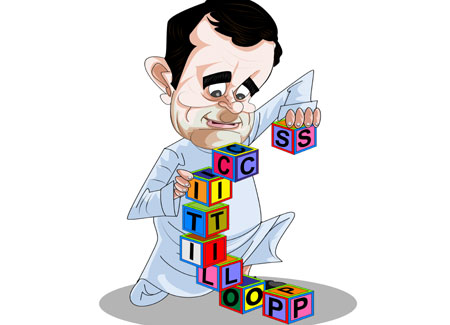
Watching Rahul Gandhi mature over the years has been about anxious anticipation of ‘The Arrival’. On a good day at the office, he is capable of getting the conversation to veer around to him and keeping it there, of driving TV news-time TRPs and then throwing in a pumped up performance that grazes the edges of an Aamir Raza Husain production. On September 27, 2013, a few months before the Modi wave broke the back of the Congress party; Rahul had made waves at the Press Club of India as he theatrically tore up a copy of a controversial ordinance the Manmohan Singh government was planning to bring in to get around a court order barring convicted politicians from contesting elections. On a list of Rahul’s top ten moments, that should rank somewhere at the very top.
A little over two years before that, in May 2011, he dropped his security detail, dodged the police and sneaked into the twin villages of Bhatta and Parsaul on motorcycle back in the course of a violent farmers’ agitation against land acquisition when Mayawati was chief minister of Uttar Pradesh. As a moment, with Rahul standing shoulder to shoulder with the farmers, and getting arrested, that should figure in the Rahul top ten too.
And then, watching Rahul, you would realise that such moments of high drama and apparent success can also be taken away from him. In the Bhatta-Parsaul case, the fizzle happened earlier this year. Dhirendra Singh, the man who drove the motorcycle to Bhatta and Parsaul with Rahul riding pillion, joined the Bharatiya Janata Party in January, mouthing the usual things about sycophancy and the Congress party having lost its way.
Rahul himself appeared to have lost his way at times, holding back to come into his own, as others waited for The Arrival. And then, with speeches at the University of California, Berkeley, Princeton University and to NRIs in New York over the last fortnight he may have signalled that his period of political incubation may be finally over.
Introspective, candid, and open on both occasions, he gave the kind of panoramic overview of people and events that got him the eye balls and his beleaguered party some hefty bragging rights. Slowly, and systematically, but never over-the-top with his criticism – knowing that the Modi wave had not ebbed – he appeared to patiently scrape away at the government’s performance. He spoke about the specter of jobless growth, insisting that whatever growth rate there might be, it had to be accompanied by creation of jobs in a democratic environment.
He provided the statistics: 12 million youth entering the job market every year, with 90 per cent having a high school education. Then, in a throwback to his father Rajiv Gandhi’s troubles over introducing computerisation, he said that automation did not take away jobs, but created the opportunity for new kinds of jobs. Jobs were the single biggest challenge facing India, apart from education, healthcare and gender equity. He conceded that it was mainly the inability to provide jobs that pushed the UPA out of power and brought Narendra Modi to office.
The most quoted part of his speech at the University of California, Berkeley, was an acknowledgment of how the Congress had been done in by arrogance in the last three years of UPA-II and stopped having “conversations with people”. He spoke about dynasty but without forgetting to tell the audience that it was an aspect of Indian political life and big business, and carefully named dynasts from across the political spectrum and Indian corporate life.
Rahul was large-hearted when he spoke about ‘Make in India’, which he described as powerful, and rued that it was a missed opportunity for the UPA because they had not thought about it. But, he shot off a critique almost immediately, telling he would have tweaked it to focus on small and medium enterprises whereas Modi’s ‘Make in India’ was about big business. And then at the New York meet, he launched a full-frontal attack on the climate of intolerance in India, and how it was ruining India’s reputation abroad.
As an image-building exercise, Rahul’s two-week US trip could not have come a moment too soon. It was good timing. With the government under pressure to revive the economy, and experts within the establishment and outside suggesting a gloomier rather than a brighter future, there was space for a counter narrative to begin. Remember how, with the UPA hemmed in by corruption scandals, Anna Hazare drew thousands to his anti-corruption movement in Delhi in July 2012 – it was because he started a counter narrative with his demand for the Jan Lokpal Bill.
Rahul’s speeches at the two universities and in New York are important, because they have managed to stall one conversation and start another. The focus is back on him, and it isn’t all mirth. In an interconnected world, he knew that wherever he spoke, people would hear him if he had something worthwhile to say. The US venues were well chosen because he was away from an environment where he was trolled as ‘Pappu’ and where the force of the rightwing attack machine derailed his messaging. The reaction in the saffron camp to his speeches in the US indicates he has hit home.
There was one other thing that Rahul spoke of openly, perhaps for the first time. It was about The Arrival. He said that he was ready for an “executive role” in the party since organisational elections in the Congress were under way. That was perhaps as much as anyone could get him to say he was ready to be party president. The trip to the US offered a peak into a Rahul who was different from “Pappu”. The anticipation of The Arrival has now been wrapped in more anxiety.
ananda.majumdar@mydigitalfc.com




